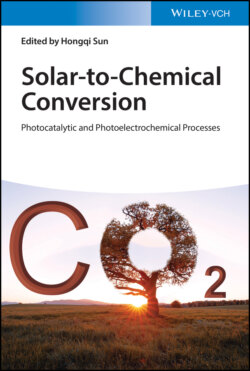Читать книгу Solar-to-Chemical Conversion - Группа авторов - Страница 20
2.4.1.3 Formaldehyde (HCHO)
ОглавлениеAs described in Eq. (2.3), HCHO is one of products that can be theoretically and experimentally formed, involving four‐electron reactions, while more elementary reactions happen during the final formation of HCHO [42]. Meanwhile, HCHO is also detected as an intermediate for fulfilling next reactions and producing CO and other advanced hydrocarbons. For example, Ojha et al. found that HCHO and COO– functioned as important intermediates to form CO over Cu‐modified S‐doped g‐C3N4 thin sheets through in situ diffuse reflectance infrared Fourier transform spectroscopy (DRIFTS) [43]. Meanwhile, it is found that the existing forms of Cu in S‐doped g‐C3N4 system include Cu0, Cu+, and Cu2+ three states, which have obvious effects in the adsorbed species and reaction pathways. Owing to the higher absorbance value on the Cu0‐decorated sheets, the bicarbonate species as an intermediate tended to promote CH4 production. Furthermore, Song and coworkers explore the selectivity and photocatalytic activity of Cu‐ or Ni‐doped TiO2 catalysts by means of a hydrolysis method for the reduction of CO2 under irradiation from Hg lamps in a CO2/NaOH aqueous solution [44]. The results display that CO, HCHO, CH3OH, and CH4 can be yielded simultaneously in Cu/TiO2 and Ni/TiO2 system, while methane is identified as the major product. At the optimum value of 1%, the CO2 conversion ability and light utilization ability reach to 29.43 μmol g−1 and 244.72 μmol gcat−1, respectively, which is almost seven times that of pure TiO2 after 24 hours UV illumination. In Ni‐doped TiO2, the maximum value of the CO2 conversion ability and light utilization ability, amounting to 43.97 and 460.30 μmol gcat−1, respectively, was observed after 24 hours UV irradiation. The CO2 conversion ability can be indirectly defined as the sum of the mole number of all independent carbon products, including CH3OH, CO, HCHO, and CH4. And meanwhile, the transformation of the photon is used to evaluate the light utilization ability, which is determined not only by the total quantity of carbon products produced but also by the H2 yield. Therefore, the light utilization ability is the sum of the CO2 conversion ability and the H2 yield, which indicates that H2 is the main product instead of reduced hydrocarbons. Recently, Garay‐Rodríguez et al. reported a Ba3Li2Ti8O20/CuO composite for selective reduction of CO2 to formaldehyde under visible‐light irradiation [45]. The highest formaldehyde production is 11.6 μmol gcat−1 h−1, which is mainly attributed to lower particle size distribution and higher surface area compared with others, allowing an increase in the CO2 adsorption.
On the other hand, owing to the ability to uptake and release electron, polyoxometalate (POM) can prolong the lifetime of the intermediate by directing the flow of the charge carriers, which enhances the efficiency of photocatalytic activity in CO2 reduction [46]. For example, Barman et al. prepared a Mo‐based polyoxometalate for selective formation of formaldehyde in photochemical carbon dioxide reduction [47]. In this system, a maximum of 0.858 mmol of formaldehyde and 0.63 mmol of formic acid were obtained in the reactions with 0.01 μmol of catalyst loading. The overall maximum turnover number (TON) for photochemical carbon dioxide reduction is 546. Meanwhile, the results present that water as an electron donor releases O2, electrons, and protons simultaneously through water oxidation process that is a pH‐dependent reaction. A plausible mechanism of HCOOH formation is proposed, where CO2 attached on Mo‐based polyoxometalate is converted to CO2 anion radical under the attack of the electron and subsequently is reduced to HCOO– and formic acid in the presence of large protons. Finally, formic acid is detached to vacate the active site to further produce formaldehyde.
To further improve the selectivity of HCHO in CO2 photoreduction, the reaction parameters and reactors have been studied in the past, as similar as other chemical reactions. Recently, Brunetti et al. reported a continuous operating mode using C3N4–TiO2 photocatalyst embedded in a dense Nafion matrix, where reaction pressure as a driving force was specifically and systematically investigated to determine reactor performance and product removal in photocatalytic CO2 reduction [48]. The results showed that under the high feed pressure (5 bar), HCHO is the predominant production and MeOH is the secondary, where the carbon conversion efficiency achieved is 61 μmol gcat−1 h−1, better performing than other photocatalytic membrane reactors. Meanwhile, the effects of H2O/CO2 feed molar ratio and contact time on the membrane reactor performance were explored. Total converted carbon instead did not vary significantly with reaction pressure.
